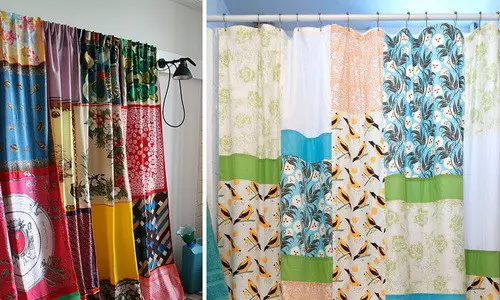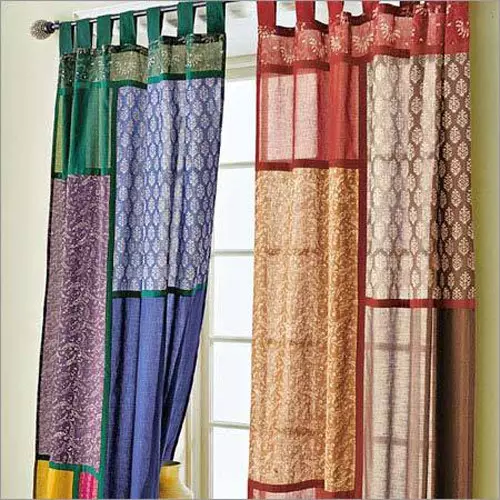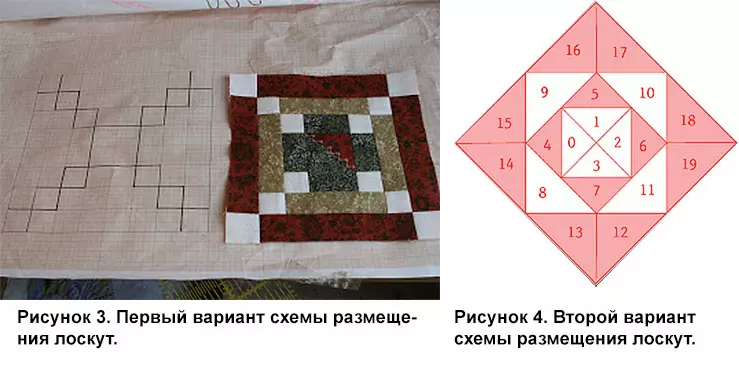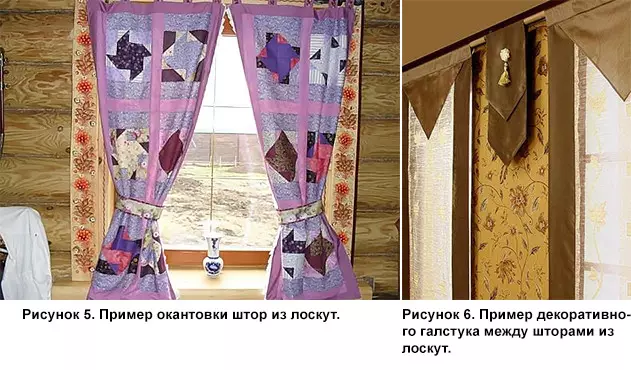The needleworks are familiar with such a situation when the patchworks of different sizes remain with the porter and sewing. It can be quite large pieces of fabric, which cannot be thrown out simply, but they are not enough for a full-fledged product. And the flaps will dig, occupying a place in the boxes and causing some desire to do something with them.

Figure 1. Patchwork curtains are a useful use of the existing tissue residues, to obtain original indoor curtains.
From the flap can be sewed a lot of useful small objects: bags, tacks, pads and other cute little things adorning life. Thinking a little and calling for help creative inspiration, large things can be made from the rest of the fabric, for example, to sew the curtains with their own hands.
Patchwork curtains will be wonderful in the interior in the style of country or modern, in the children's room they will give the necessary playfulness of the design, and the curtains resembling Japanese panels will look harmoniously almost in any room.
The simplest solution is patchwork curtains
Material for their manufacture can serve any flaps, even with different textures and density. In addition to flap must be prepared:
- needle with thread, pins - for fastening elements during sewing;
- decorative braid, thin satin ribbon, etc.;
- curtain tape;
- sewing machine;
- Measuring tape, ruler, pencil.

Figure 2. Curtains from the flap can be perfectly fit into the interior of the room in the style of Country or Modern, giving it comfortably.
- Work begins with the removal of the size of the window or doorway, to which the curtains will be sewn. The dimensions are transferred to the scheme on which parts from the flap will be discharged and numbered. When drafting the scheme, you need to take into account points on the seams between the elements (1 cm), the bending bending (4 cm), the treatment of lateral seams (2 cm on each side) and a row with a scallop or without it. The dimensions of this battery are established individually.
- The flaps of the new fabric are desirable to wrap in warm water and turn out the "sat down". This process is called decatting. Do this in order that in the future the finished product does not twist as a result of an uneven shrinkage of different pieces of fabric. If you have already been accepted already used things, they only need to turn them out to work more comfortably.
- The simplest variant of the patchwork curtains is rectangular pieces stitched in an arbitrary order, with alternating dense and transparent, dark and light elements of different sizes. The flaps are unfolded and connected "on the living" with the help of a needle with a thread or spin into pins so that when sewing all the edges of the seams are on the outline of the product. With a large number of items, first curtains are collected, stitching from them afterwards everything canvas. Fig. one.
- A more complex option involves a symmetrical selection of pieces of the same magnitude and textures on each of the 2-cloth curtains and finishing the finished product with a tape or a ribbon that hides the seams between the elements. Fig. 2.
Article on the topic: Sound-absorbing panels do it yourself: a sequence of actions

Figures 3, 4. Options for location of the flap for curtains.
At the top of the curtains make a stretch, converting the edge of the fabric into several centimeters and laying the seam. For the formation of the scallop, the bending is made of greater widths and in its lower part lay 2 parallel seams, making a stem. Above it remains a strip folded halved tissue forming the scallop.
If the length of the patching curtain does not allow you to make a scene and scallop, it is processed, flexing the edge, and hang on the clips or hooks on the cornice. You can independently make wide loops from the tape or tissue bands, which will serve as an additional decorative element of the curtains.
How to sew a chart in the style of patchwork?
When there are many small pieces of multi-colored tissue in the presence, you can collect separate squares with a pattern of triangles or rectangles. These fragments are then stitched together, receiving a canvas of any size.- On paper draw a scheme (Fig. 3, 4), linen pieces of fabric, not forgetting about allowances on the seams, and collect a trial fragment. In order to present the future result, you can use the Photoshop program, photographed a trial fragment and spreading it.
- Finished fragments to sew and make a suitable edging from the bands, loops or a row to sew separately. Fig. five.
"Japanese" curtains from tissue residues

Figures 5, 6. Examples of edging curtains and decorative flap tie.
Real Japanese curtains are traditionally made from separate cloth bands 60 cm, fixed on a special carnous, which makes it possible to move each canvas regardless of others. They differ from European the fact that the canvas are not draped and have a racking bar at the bottom. Based on the idea of traditional Japanese curtains, they can make their option from trimming fabric, the length of which is sufficient for a full-fledged curtain, and the widths are not enough for a standard window or doorway.
Article on the topic: All about how to change the bath
To work will be required:
- Long strips of transparent fabric (tulle, veil, etc.);
- The same strips of a more dense opaque material can be less width;
- Slotel Planks (Window or Smooth Rake Stroke);
- needle with thread, pins;
- sewing machine.
To create a pseudoyapon curtains, measure the transparent tissue bands. The length of them is equal to the desired height of the curtains. The width of the cloth should be the same.
From the lanes of opaque tissue, carve out the side edging, a scene and a decorative element of a triangular shape. The sizes are selected with such a calculation so that the cloth assembled from the transparent middle strip and 2-opaque sidewalls had a width sufficient to completely close the window opening. When calculating the height, the allowance for a bending allowance is sufficient to place the strip of the weighting agent within it.
The length of the strip for the scene is equal to the width of the corders collected from the strips, and the width should allow you to freely wear it on curtain from the tube or tree. The length of the hypothenus of triangular "lambrequin" is slightly smaller than the width of the curtains.
Sewing curtains to produce like this:
- Sustrate the central and side strips, process the side slice, bending the edge of 1 cm.
- Treat the edges of the riding and triangle cathets.
- Fold alternately (face up), the triangle (face up, the edge of the hypotenuses is combined with the top of the top), one of the long sides of the scene (with an in-up). Smealance or scroll pins.
- Beat the scene up and over-off the curtains inside out, flexing the edge inside, secure it at the seam level on the front side of the product.
- Carefully perform a line on the machine, connecting elements.
- Seal the bottom curtains and push.
The finished product must be carefully rejuvenated and insert a weightlifier into the lower bending. Between the panels and window openings can be hung with a ties crosslied from the same tissue that perform the role of a decorative element. Fig. 6.
Curtains from the residues of the fabric stitched with their own hands can be supplemented with brilliant beads, sequins or rhinestones, decorate with brushes or embroidery, pickups. In each case, these curtains will be individual and unique, even if you do in general schemes.
Article on the topic: How much hissing wallpaper glue on various wallpaper
